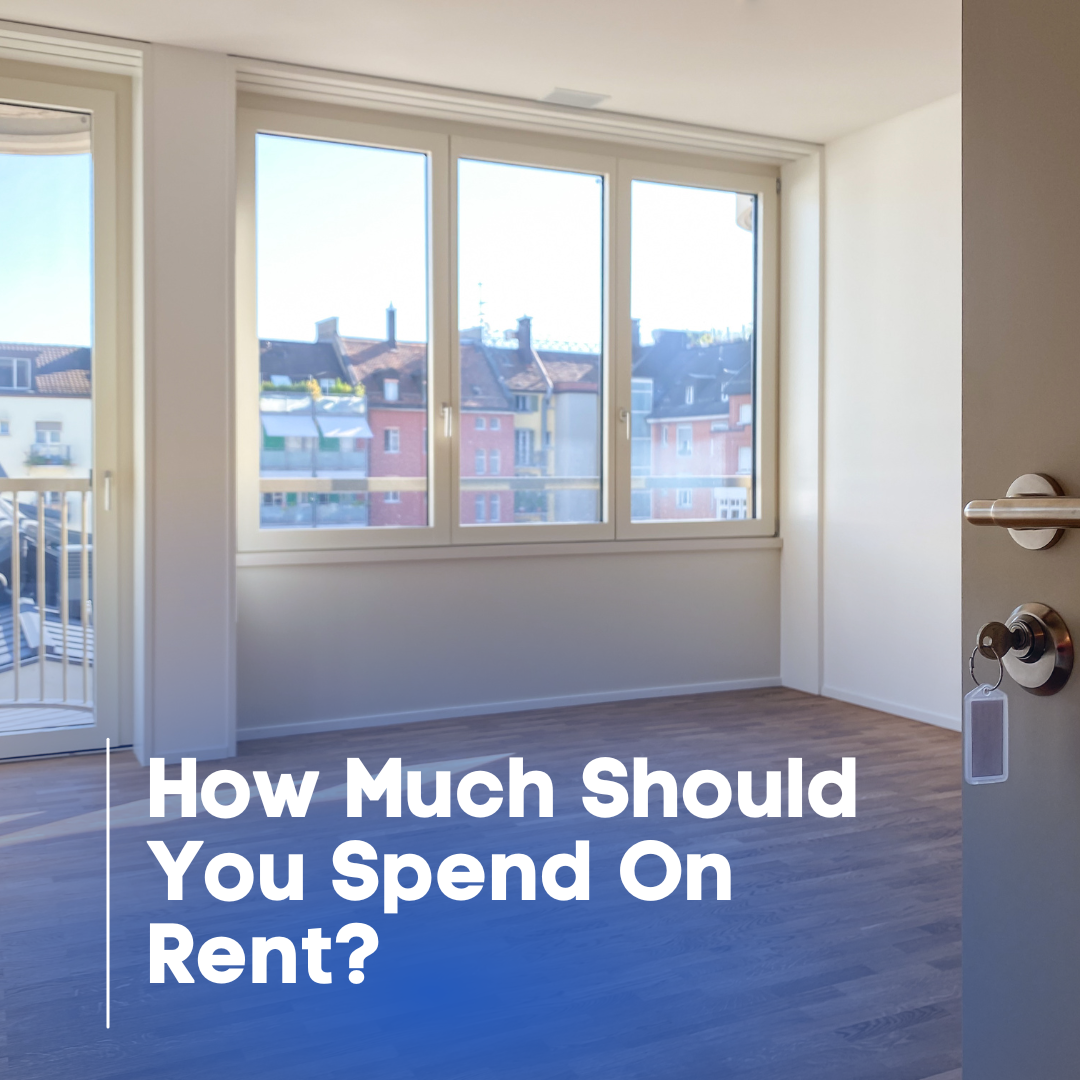
How Much Should You Spend On Rent?
September 17, 2020 8:38 pm Leave your thoughtsDiscover how much you should spend on rent! Apartment living is continually on the rise as more tenants start their renting journey. As home prices increase, more people are being drawn to the advantages of renting. The downside is that with more people living in apartments comes higher rental costs. Your rental cost can vary by location, amenities, roommates, floor plan, and utilities. It’s important to know what rental prices you can expect so that you can prepare accordingly.
Perhaps you have found yourself in a living situation where you’re paying an excessive amount of rent, and you’re wondering if it’s really worth it. In this blog post, we will explore how much you should be paying for rent so that you can ensure you’re making the most effective decisions. We’ll also cover cities with the highest and lowest rental costs, as well as how much of your income you should allocate to rent.
The rent price that works best for your lifestyle is more than just plugging numbers into a calculator. It’s essential to consider other factors, such as the amenities your apartment will provide, proximity to local attractions, and more. To maximize your living experience, you need to analyze the entire community, not just the cost. Ensure that you consider the full picture of renting before you make an apartment decision!
The 30% Rule for Renting
The 30% rule came from the U.S. government’s guidelines on housing affordability. It suggests that individuals should spend no more than 30% of their monthly income on rent. Historically, this rule was created so that households could afford essential expenses while maintaining proper housing. However, in today’s diverse economic landscape, it is clear that the 30% rule may not always align with individual circumstances. It may be unrealistic for many locations and may not be helpful to consider.
For instance, in high-cost areas, following the 30% threshold might mean compromising on living standards or location convenience. In contrast, for individuals with low incomes or those living in areas with more affordable housing, allocating 30% of their income to rent might be too much. The 30% framework can be helpful to evaluate your rent. If you feel that it does not apply to your scenario, then there are other ways that you can assess your financial situation and reach a more informed decision.
Many renters don’t realize the 30% rule was not originally designed as a personal budgeting tool. It came from the U.S. Department of Housing and Urban Development (HUD), which used it to identify households considered cost-burdened. It was meant to flag broader housing affordability problems across the population, not dictate what each person should spend.
Over time, the rule turned into financial advice, which pressures people to see it as a benchmark of success or failure. If your rent is above 30%, it does not mean you are irresponsible. It shows the current housing market often does not fit the old guidelines. Use the rule as one reference point, not a moral judgment.
Evaluate Your Financial Situation
It’s essential to start planning for rent by reviewing your financial standing. This will help you determine how much to spend on rent. Start by calculating your total monthly income, including your expenses, investments, and any other sources of revenue. From here, you will want to list your ongoing expenses, such as groceries, utilities, transportation, and debt, among others. Be thorough to ensure that you’re tracking everything, both in terms of saving and spending.
The next step will be to lay out your financial goals, as this will be essential for making informed decisions about your rental budget. Take time to reflect on short-term and long-term financial objectives. The choices that you have in the future will impact these goals, as well as your individual lifestyle choices.
You should also plan to use a resource that will help you calculate your rent affordability. Use a rent affordability calculator to account for how much of your income should be set aside for rent every month. Monthly rent shouldn’t put you in more debt, and that’s why it’s essential to calculate the associated costs beforehand. Once you have a clear rental budget in mind, you can be more productive with your apartment search. It’s essential to remember that your personal finances are, by definition, personal and may differ from those of others.
Balancing Rent and Debt Payments
If you have student loans, credit cards, or car payments, treat them as non-negotiable fixed expenses before setting your rent budget. Use this simple guide:
- List your monthly take-home income.
- Subtract your minimum debt payments.
- Subtract essential expenses such as utilities, groceries, and transportation.
- What’s left is the most rent you can afford without reducing your savings.
Example:
$3,200 monthly take-home pay
$600 loan payments
$400 transportation
$500 groceries and utilities
This leaves $1,700. That is your safe limit for rent, even if 30% of your gross income suggests a higher amount.
Gross vs. Net Income: Which One Should You Use?
A common source of confusion when planning for rent is whether to budget using gross income (pay before taxes and deductions) or net income (the amount deposited into your bank account). Landlords usually use gross income when applying the “3x rent” rule because it is a fixed figure that does not change with tax withholdings or retirement contributions. For personal budgeting, it makes more sense to use net income since that shows your actual spending power.
To balance both, calculate each. Check your gross income against landlord requirements to see what you qualify for, then use your net income to measure how manageable that rent will feel each month. This approach removes guesswork and prevents the surprise of finding that the rent you qualify for on paper leaves little room for daily expenses.
Adapting the 30% Rule to Real Life
Instead of treating 30% as a hard line, think of it as a range that moves with your circumstances:
- Low debt, strong savings habits: Spending closer to 35%–40% of your net income on rent may be reasonable if it shortens your commute or improves your quality of life.
- High debt, little savings: Aim closer to 25%–30% of your net income to leave breathing room for loan payments and emergencies.
- HCOL areas: If your rent falls between 40% and 50%, make sure you balance it with savings elsewhere, such as avoiding a car payment or sharing housing costs.
Example: A $55,000 salary equals about $3,284 in monthly take-home pay.
30% of gross income → $1,375 per month in rent.
30% of net income → $985 per month in rent.
Adapted range: $985 to $1,375, based on debt and savings goals.
Considering Location and Lifestyle
The location of your apartment is likely the number one indicator of how much money you will spend on rent. Where you’re located can make a massive difference in the amount of money that you’re spending each month, from your commute to work and local attractions to the general cost of living in that area. It’s a crucial step in the rental process to calculate these factors in addition to the rent price.
For example, if you have a long commute to work each day, the gas cost will factor into your overall monthly budget. If you live near public transportation, you can save on commuting and perhaps spend more on rent. It’s more than just considering your income. It’s looking into what your day-to-day routine will look like, and how that will affect your spending.
Below are the cities with the highest rental costs in the U.S. These cities have a high demand for housing, limited availability of rental units, and usually strong job markets.
- San Francisco, California
- New York City, New York
- Boston, Massachusetts
- Washington, D.C.
- Los Angeles, California
- Seattle, Washington
- San Jose, California
- Oakland, California
- San Diego, California
- Miami, Florida
In high-cost cities, people often spend 40 to 60 percent of their income on rent. Although this may feel alarming, many renters compare it to other savings. For example, living in Manhattan, with higher rent but no car expenses, may be less expensive than living in Los Angeles, where rent is lower but owning a car is required.
When comparing apartments, include your total cost of location, which is rent plus transportation, utilities, and fees. This helps you see which option leaves you with more room in your budget, even if the rent amount looks higher on its own.
Below are the cities with the most affordable rental costs in the U.S. These cities typically have lower costs of living, less demand for housing, and/or a higher availability of apartments.
- Wichita, Kansas
- Tulsa, Oklahoma
- Toledo, Ohio
- Tucson, Arizona
- El Paso, Texas
- Albuquerque, New Mexico
- Memphis, Tennessee
- Oklahoma City, Oklahoma
- Indianapolis, Indiana
- Louisville, Kentucky
The amenities that your apartment has also relate to your rental costs. Personal amenities, such as in-house washers and dryers, as well as free parking, can help limit the amount of money you spend outside of rent. Community amenities can also impact your budget. Many apartments now include a wide variety of features and services to make your life easier. These can include anything from a pet wash station to a fitness center.
The right combination of amenities could help limit your cost of living in other areas. It’s important to be aware that apartments may charge you additional fees beyond rent. So, regardless of what you’re looking for, it’s essential to consider how your new amenities will affect your wallet. The right amenities can improve your lifestyle and help you save money at the same time!
The 15 Hidden Costs to Ask About Before Signing a Lease
Always ask the landlord or property manager:
- Utilities (water, sewer, gas, electricity, trash)
- Internet/cable bundles (mandatory or optional)
- Parking (garage, lot, street permits)
- Pet rent (monthly, not just deposit)
- Amenity fees (gym, pool, lounge access)
- Package delivery/storage fees
- Trash valet service
- Renter’s insurance requirement
- Online payment “convenience” fees
- Move-in fees (elevator, cleaning, admin)
- Application fees (often non-refundable)
- Security deposit terms (refundable conditions)
- Early termination fees
- Key fob/remote replacement costs
- Mandatory pest control or tech service fees
When Rent Consumes 40–50% of Your Income
In high-cost cities, rent often consumes half your paycheck. To manage this without falling behind financially:
- Choose a floor, not a target. Select the smallest unit you can accept, such as a studio instead of a one-bedroom apartment.
- Use the “cost of location” formula. Add rent, utilities, transportation, and fees. Compare total costs across neighborhoods, rather than just looking at the listed rent.
- Time your move. Relocating during off-peak months, from November to February, can lower rent by 5–10%.
- Consider roommates as a strategy. Even at higher incomes, sharing a unit is often the only way to live close to job centers.
Planning Your Budget for Security Deposits
The deposit typically equals one month’s rent, but it can vary. For example, in high-demand cities like San Francisco or New York, you may need to budget for a deposit equivalent to two months’ rent due to the competitive rental market. On the other hand, in cities with lower rental demand, such as Wichita or Tulsa, the deposit may match the standard one-month rate.
The amount you’ll need for a security deposit also depends on the apartment’s condition and the amenities it offers. A newly renovated apartment with high-end finishes might require a higher deposit compared to a more basic unit.
What if you do not meet the 3x rent rule?
Many landlords require your gross monthly income to be at least three times the rent. This rule comes from the 30% guideline and works as a simple screening tool. If your income is lower, you still have options:
- Roommates or co-signers: Adding another tenant or using a guarantor with stronger income can meet the rule.
- Larger deposits or prepayment: Some landlords may accept a higher security deposit or several months of rent upfront.
- Alternative proof of stability: Freelancers and workers with variable income can show tax returns, bank statements, or steady contracts.
Not every landlord is flexible. Smaller property owners are often more open to alternatives than large corporate complexes.
Renting with Irregular Income
If you freelance, work gig jobs, or earn seasonal income, proving financial stability can be hard. Most landlords expect steady pay stubs, but many modern workers don’t have them. Instead, prepare a portfolio of documents:
- Two years of tax returns
- Recent bank statements that show consistent deposits
- Signed client contracts or proof of current projects
Some renters open a separate savings account specifically for rent and show landlords the balance to demonstrate their reliability. The key is to show consistency, even if your income isn’t traditional.
Budgeting with Variable Pay
For freelancers and gig workers:
- Base rent on your lowest income. Use your slowest month as the benchmark. For example, if you earn $4,000 in a strong month but only $2,500 in a slow one, budget as if $2,500 is your income.
- Create a rent reserve. Save 3 to 6 months of rent in a separate account. This turns uneven income into steady paychecks you can transfer to yourself.
- Use a self-pay system. Each month, transfer the same fixed amount from your reserve to cover rent. This smooths out the highs and lows.
Budget For a Pet-friendly Apartment
- Dog: For a dog, you might encounter a one-time pet deposit ranging from $200 to $500, depending on the apartment complex. Additionally, there could be a monthly pet fee of $25 to $50 per dog.
- Cat: Cats generally have similar deposit and fee structures as dogs, with a one-time pet deposit typically ranging from $100 to $300 and a monthly fee of $20 to $40 per cat.
- Small Mammals (e.g., hamsters, guinea pigs): Small mammals typically don’t incur additional apartment fees. However, you’ll need to purchase a suitable cage or enclosure, which can range from $20 to $100 or more depending on the size and quality.
Tips for Finding Affordable Housing
It’s no secret that rental prices are rising across the nation. As for single-family housing, rents are now 36.6% higher than pre-pandemic prices – compare that with multifamily apartment prices, which have gone up 23.6% since before the pandemic. Many people face the reality of needing to find homes that are more affordable and better for their budget. Finding affordable housing can be a challenge, so use the tips below to locate your next apartment.
- Research Rental Markets: Take the time to research options in different neighborhoods or cities. Look for areas where rent prices are more affordable while still meeting your needs in terms of location and amenities.
- Consider Roommates or Shared Housing: Sharing an apartment with roommates can significantly lower your housing costs. Just be sure to find compatible roommates and establish clear agreements regarding rent, utilities, and household responsibilities.
- Explore Alternative Housing Options: Consider alternative housing options such as renting a room in someone’s house, co-living spaces, or affordable housing programs offered by local government or nonprofit organizations.
- Be Flexible with Location: Expanding your search area beyond the most expensive neighborhoods or cities can lead to more affordable housing options. Look for neighborhoods that may be up-and-coming or undergoing revitalization, where rents may be lower. It may be a short distance away, but it has an entirely different cost.
- Look for Rental Incentives: Keep an eye out for move-in specials or waived application fees. These incentives can help lower your upfront costs and help you move in at a closer date.
- Check for Income-Restricted Housing: Some housing developments offer units at reduced rents for individuals or families with lower incomes. Look for income-restricted housing options in your area and see if you qualify.
- Seek Financial Assistance: If you’re struggling to afford rent, look into financial assistance programs offered by local government agencies or nonprofit organizations. These programs may provide rental subsidies, rental assistance, or other forms of financial aid to eligible individuals or families.
- Government programs usually define affordable rent as 30% of household income. Common programs include:
- Housing Choice Voucher (Section 8): Provides help with rent in private housing.
- LIHTC (Low-Income Housing Tax Credit) apartments offer below-market rents to qualified households.
- State and local rental assistance portals: Many states run their own online applications.
Search your local housing authority’s website or HUD’s Affordable Housing Search Tool to check eligibility.
Why Does Rent Feel So High?
Renters often point out that rising rents are not only about demand. Larger systemic issues shape them. In many markets, limited housing supply, restrictive zoning, and corporate landlords that use pricing algorithms drive up costs. This can make it feel like no matter how carefully you budget, the system is stacked against you.
You can’t control the market, but knowing these forces are at work can help you see your situation more clearly. If your rent feels unaffordable, it is not a personal failure. It is often the result of a broader housing shortage and policy environment.
Weighing Rental Cost Trade-offs
Consider the lifestyle trade-offs of spending more or less on rent. Spending more on rent may give you a nicer living space in a better location. It could also bring you closer to amenities or provide you with a shorter commute to work. On the other hand, spending less on rent may free up more money for other financial goals or needs. It could also result in sacrificing amenities, living in a less desirable neighborhood, or facing a longer commute. It’s essential to weigh these lifestyle trade-offs carefully and prioritize what matters most to you.
Every dollar spent on rent is a dollar that cannot go towards other financial needs. Consider whether the benefits of a more expensive rental justify the cost. While it’s essential to prioritize affordability and avoid overspending on rent, it’s also important to consider how your choices will impact your overall quality of life. Take the time to find a balance between affordability and quality of life. Search for a rental property that meets your basic needs while also aligning with your lifestyle. By finding this balance, you can enjoy a comfortable and fulfilling life without jeopardizing stability.
Planning For Future Rental Costs
Considering how your housing needs may change over-time is essential for long-term financial success. As life circumstances evolve, such as changes in family size, career opportunities, or health considerations, your housing needs may also shift.
You should carefully set aside savings for unexpected expenses. Be prepared for rent increases that may often be outside of your control. You can also establish an emergency fund specifically for housing-related expenses. Additional savings can provide a safety net in case of unforeseen circumstances. Keep in mind that you should reassess your budget periodically to adapt to changing circumstances. This will help you move forward with confidence and minimize the financial strain associated with surprise costs.
Before signing a lease, save at least three months of rent and utilities in an emergency fund. This fund protects you if you lose income or face unexpected expenses. In high-cost cities, try to save about six months of housing costs for added security.
Keep in mind that utilities can often be a cost that takes both residents and prospects by surprise. These expenses can change based on various factors outside your control. Some apartments may have utilities included, while others require you to pay separately.
It’s essential to include a detailed estimate of your utilities in your rental cost. The type of utilities you pay for can significantly influence how much you will be paying every month. As you look to your future of renting, consider all the financial factors that will impact you.
Age and Salary Benchmarks for Rent
Rent affordability changes with each stage of life. Treat these numbers as general benchmarks, not strict rules:
- Early 20s, entry-level salary ($40k–$60k). Keep rent low, around 25–30% of net income, so you can pay down debt and build emergency savings.
- Late 20s to 30s, mid-career salary ($70k–$100k). Spending 30–35% of net income can be reasonable if it improves daily life or shortens your commute.
- Families or dual incomes. Choose housing that allows you to save at least 10–15% of your combined income, even if rent is higher.
Special Rent Guidelines for Different Life Stages
College students: Try to keep rent between 20% and 25% of income from jobs, aid, or family support. Budgets are often tight and unpredictable, so roommates are usually necessary.
Young professionals: Spending up to 35% can work if the location shortens commutes or supports career growth.
Remote workers: Balance higher rent for a home office or larger unit with savings from not commuting.
Retirees: Focus on stability. Even with pensions or savings, keeping rent below 30% preserves funds for healthcare and other fixed costs.
No car payment: If you don’t own a car, you may be able to spend 5–10% more on rent. Weigh this carefully against long-term savings.
Find Your New Apartment Today!
Categorised in: Apartment Living
This post was written by Isabella Housel
Isabella Housel is a passionate and versatile professional writer with a deep love for words and a commitment to crafting compelling content that engages, informs, and inspires. With many years of experience in the industry, she has honed her skills across various genres, from creative storytelling to informative articles and technical documentation.




